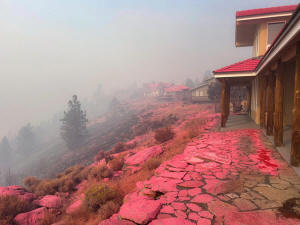Firefighters and weather are stabilizing Oregon wildfire. Flames so far
spare California wineries
[August 26, 2025]
By TAMMY WEBBER and JULIE WALKER
A wildfire that destroyed four homes in central Oregon was starting to
stabilize on Monday, authorities said, while a blaze in Northern
California wine country has so far spared some of the state's most
famous vineyards.
Moisture helped the 1,200 firefighters battling Oregon's Flat Fire, but
more work needed to be done. Dry, hot weather had fueled a rapid
expansion of the blaze across 34 square miles (88 square kilometers) of
rugged terrain in Deschutes and Jefferson counties since the fire began
late Thursday.
“Gotta love Mother Nature. It brought in a little bit of rain. Cooled
the temps, relative humidity came up,” Travis Medema, the state's chief
deputy state fire marshal, told a community meeting in the town of
Sisters. “The incident, for the first time in the last three days, is
really beginning to stabilize.”
Officials said firefighters had protective lines of some sort around the
entire fire, including roads, but the fire remained at 5% containment.
Authorities at one point ordered evacuations for more than 4,000 homes
but lifted orders for some areas in the evening.
A heat advisory was in place through Wednesday, and forecasters warned
that potential thunderstorms could create erratic winds that would
challenge firefighters.
Flames in California's wine country
Meanwhile, the Pickett Fire in Northern California has charred about 10
square miles (26 square kilometers) of remote Napa County, known for its
hundreds of wineries. It was 15% contained on Monday.
Flames spared the home and adjacent vineyards of Jayson Woodbridge of
Hundred Acre wines, but he said it was a close call on Thursday when the
fire broke out and raced along nearby slopes.

He and his son grabbed hoses and futilely began spraying down the steep
hillsides. “The water was evaporating as fast as we were spraying it out
there,” Woodbridge recalled Monday. “It was just a hot funnel of air.
Fire was just engulfing everything.”
Before long, crews with bulldozers and air support arrived to protect
the property. Water-dropping helicopters continued their flights on
Monday, keeping the flames contained to canyons about 80 miles (130
kilometers) north of San Francisco.
With about a month to go before harvest, Woodbridge said his grapes
won't be damaged because of the “pure luck” of wind direction.
“The smoke won’t affect the fruit because the wind’s coming in from the
west, thankfully,” Woodbridge said. That wasn't the case in 2020 when
toxic smoke from the Glass Fire caused Woodbridge and other wineries to
scrap much of that year's crop.
There have been no reports of damage to any vineyards from the Pickett
Fire, said Michelle Novi with Napa Valley Vintners, a nonprofit trade
association.
Firefighting resources have been put in place to protect wineries,
especially as winds pick up later in the day, according to the
California Department of Forestry & Fire Protection, or Cal Fire.
[to top of second column]
|

Deschutes County Sheriff's Office shows shows homes covered in fire
retardant dropped from firefighting aircraft for battling the Flat
Fire in central Oregon, Sunday, Aug. 24, 2025. (Deschutes County
Sheriff's Office via AP)

“With the weather over the last 48 hours, we're seeing high
temperatures, low humidity paired with some increasing wind in the
late afternoon, which was giving our troops some additional work on
the eastern side of this incident," Cal Fire spokesperson Curtis
Rhodes told The Associated Press on Monday.
A firefighter dies in Montana
In southwest Montana, a 60-year-old contract firefighter from Oregon
died Sunday afternoon, from a cardiac emergency while battling the
Bivens Creek fire.
Ruben Gonzeles Romero was among more than 700 firefighters working
on the lightning-caused fire in the Tobacco Root Mountains about 15
miles (24 kilometers) north of Virginia City, Montana.
The Bivens Creek fire has burned approximately 3 1/2 square miles (9
square kilometers) since Aug. 13 in a remote area with thick timber
and numerous dead trees.
Heat wave complicates the firefighting efforts
Residents of the western United States have been sweltering in a
heat wave that hospitalized some people, with temperatures hitting
dangerous levels throughout the weekend in Washington, Oregon,
Southern California, Nevada and Arizona.
After a weekend of triple-digit temperatures, authorities in
Multnomah County, Oregon, said they were investigating the death of
a 56-year-old man as possibly heat-related.
The area of the Oregon fire is in a high desert climate, where dried
grasses and juniper trees are burning and fire is racing through
tinder-dry canyon areas where it’s challenging to create containment
lines, said Deschutes County sheriff’s spokesperson Jason Carr.
In central California, the state’s largest blaze this year, the
Gifford Fire, was at 95% containment Monday after charring nearly
206 square miles (534 square kilometers) of dry brush in San Luis
Obispo and Santa Barbara counties since erupting on Aug. 1. The
cause is under investigation.
Although it’s difficult to directly tie a single fire or weather
event directly to climate change, scientists say human-caused
warming from burning fossil fuels like coal and gas is causing more
intense heat waves and droughts, which in turn set the stage for
more destructive wildfires.
All contents © copyright 2025 Associated Press. All rights reserved
 |